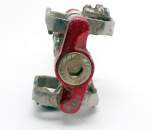What better way to celebrate “Black Friday” than with a CXM New Product Spotlight and Review? Avoid the crowds and check out Ritchey Logic’s newest pedal right here. This review supplements the comprehensive pedal reviews in our “Pedal Envy” article in Issue 7. Update: Long-term test feedback with worn cleats added, September 2011.
by Andrew Yee
Cyclocross Logic
Ritchey Logic has had a long involvement in cyclocross, outfitting cyclocross legends and national champions like Switzerland’s Thomas Frischknecht and California’s Shari Kain with components and frames as early as the mid 90’s. While the company is now more famous for its popular road and mountain cockpit components, its pedals have been one of the company’s most popular off-road components over the last two decades.
Ritchey Logic has been making mountain bike clipless pedals for almost as long as Shimano, releasing their V1 pedal just a few years after Shimano’s first model. The company has typically taken an approach to provide a lighter alternative to Shimano’s SPD models. Ritchey is now on its fifth iteration of its clipless mountain pedal, but strays from the V# (V1, V2, V3, V4) naming convention with the “Paradigm” name.
Early V1 and V2 versions provided a lightweight, lower-profile option for off-road cyclists and featured a proprietary cleat. The V3 pedal offered a Shimano-licensed retention mechanism and complete compatibility with Shimano cleats but weighed in at similar weights to a Shimano model. The fourth version, still available from Ritchey, offers three models: the 340 gram Comp, the 280 gram Pro, and the titanium-bodied 245 gram WCS and returned to a Ritchey-specific cleat for their Pro and WCS models to allow a lower cleat position. The company clearly has a lot of experience in pedal design, and has continued to refine its design with a new model every few years.
A New Paradigm

Ritchey Logic's new Pro Paradigm mountain clipless Pedal is affordable and light. © Cyclocross Magazine
Enter Ritchey’s fifth design, the $134.95 Pro Paradigm pedal. We gave you an early look at this pedal from our Sea Otter and Interbike product news, but now we finally got our feet on a pair to test.
Ritchey is now back to a Shimano-compatible cleat and down to just one model, an aluminum body rotating on a chrome-moly pedal spindle with an inner bushing and a sealed cartridge outer bearing. The pedal comes in two colors, red and black. We tested an early pair that came in red.
The two main differences of the new Pro Paradigm pedal over a Shimano alternative are a lower cleat position and weight savings. Our test set of pedals weighed just 254 grams, one gram lighter than the list weight, an impressive mark for a steel-spindled pedal.
The pedal offers a slightly smaller target than a Shimano XT or XTR pedal despite the Shimano cleat compatibility, mostly because of the thinner retention bails. Compared to an XT pedal, the cleat sits just over 2mm lower relative to the pedal spindle, requiring a slightly lower saddle height but offering what many say are superior bio mechanics. Like Shimano pedals, the Paradigm has a rear spring for a toe-down entry.
Although I didn’t need to and didn’t try, the pedal can be easily user-serviced. A 5mm hex key gives you access to the cartridge bearings, and a 2.5mm hey key keeps the bails and springs in place.
Clipping In and Out
Before even going for a ride, when installing these pedals (with an 8mm hex wrench), I couldn’t help but notice the weight difference. Offered at $5 less than the $140 Deore XT pedal and nearly 100 grams lighter, the Paradigm pedals offers a weight weenie in the market for pedals the perfect scenario: saving money while saving weight. As a weight-savings upgrade over Shimano XT pedals just to save weight, they don’t quite hit the dollar-per-gram benchmark, but are close.

Ritchey Logic's new Paradigm pedal has a flat "off" side that can be make clipping in tricky. © Cyclocross Magazine
When clipping in, finding the right position took a bit more searching than with a Shimano pedal. At first, I assumed it was simply because it was a new pedal that I wasn’t used to, but over time I came to realize the smaller surface and sharper edges of the cleat retention mechanism (compared to the larger, more contoured bails of a Shimano pedal) were the reasons for it took a bit more “feel” to clip in. However, it still offers more surface area than the popular Crank Brothers Egg-Beater.
Clipping in also requires a bit more care because the squared-off edge of the retention bails create a bit of a four-sided nature to the pedal. It’s possible to step on the “off” sides of the pedal in attempt to clip in, and unfortunately no amount of force will get you in. So it takes some practice and an occasional glance initially to make sure you’re stepping into the the actual retention mechanism.
Clipping out had a nice, audible snap, and there was never any doubt whether I was clipped in. Releasing from the pedals is easy with new cleats, but not quite as smooth as a Shimano pedal, perhaps because the Paradigm has a contoured pedal body and smaller bails, creating more pressure points than the flatter Shimano pedal with larger bails. But it was still predictable and smooth. Spring tension is easily adjustable with a 2.5mm hex key.
Update: With worn cleats, the release mechanism was problematic. Although everyone should regularly replace their cleats, worn cleats made release much harder, and in fact several times I crashed because I could not get my foot out in time for a dismount.
Mastering Mud?

The Pro Paradigm's spring tension adjustment screw and its housing provide a barrier to mud clearance. © Cyclocross Magazine
With its smaller bails and low-profile body, the Ritchey Pro Paradigm clipless pedal looks to have superior mud clearance over a Shimano pedal, and some rare early-season Northern California mud allowed some good testing of whether this would prove true.
Once I was deep into mud, to my surprise, the Pro Paradigm pedal packed with mud and organic matter a bit more than a Shimano design. Initially I struggled to figure out why. I even did several rides with one Ritchey pedal and another Shimano pedal just to confirm there was actually a difference in their mud performance. There was. Why?
Because the Paradigm pedal has thinner bails, the spring tension adjustment screw at the back of the pedal sits almost 5mm closer to the cleat, and is aligned perpendicularly to the pedal surface, as opposed Shimano’s angled screw. Furthermore, unlike Shimano’s design where much of the bare screw is exposed, the Ritchey Paradigms adjustment screw is housed in and protected by a 1cm wide enclosure – not an insignificant width in an opening that’s only 2.4cm wide. The end result is that there’s less room for mud to escape when you’re clipping in. It’s not a big deal in really wet mud, but when things get sticky or there’s a lot of organic matter, it becomes an issue.
The Final Spin
With an impressive weight, user-friendly features, Shimano cleat compatibility and a low cleat height, all for a reasonable price, the Ritchey Pro Paradigm pedals deserve strong consideration for cyclocross racers in drier climates or weight weenies on a budget. While not quite matching a modern Shimano pedal in terms of ease of entry and exit, the pedals offer a predictable and reliable retention mechanism while shedding nearly 100 grams of rotating weight.
Unfortunately, it sheds grams better than mud, and when the conditions get messy, the Pro Paradigm is a step back compared to Shimano’s relatively open redesign, and doesn’t come close to the mud clearance offered by Crank Brothers, Look and Time. If you are lucky to have a dedicated pit bike and pit crew, this may not be an issue for you.
But the full winter rains have yet to arrive here in NorCal, and while mud is uncommon, picking up my bike during a race isn’t, giving me multiple opportunities to appreciate the weight savings. So until the mud comes or I gain more upper body strength, the Ritchey Logic Pro Paradigm pedals will likely stay on one of my bikes.
Ritchey Logic Pro Paradigm Clipless Pedals:
MSRP: $134.95
Availability: Soon
Weight: 254 grams
Body: Aluminum
Axle: Chrome-Moly, no pedal wrench flats, 8mm hex wrench required
Bearings: Inner bushing, outer sealed cartridge bearings
Cleat: Shimano compatible, two bolt
Spring tension adjustment: Yes
For more information: Ritchey Logic
Photo Gallery:



































